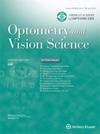中重度糖尿病周围神经病变与干眼症风险增加有关。
IF 1.8
4区 医学
Q3 OPHTHALMOLOGY
引用次数: 0
摘要
意义本研究采用糖尿病周围神经病变的有效诊断标准,确定了糖尿病周围神经病变患者患干眼症(DED)的风险增加。目的眼表平衡的破坏与糖尿病有关。然而,这种关联是否会受到继发于糖尿病的周围神经病变的独立影响仍不清楚。本研究旨在调查 DED 的临床症状和体征及其与 2 型糖尿病患者周围神经病变严重程度的关系。所有参与者都接受了详细的 DED 评估,评估方法包括干眼问卷(眼表疾病指数、干眼问卷-5)、泪液渗透压、脂质层厚度、无创角膜造影泪液破裂时间、酚红线试验(PRT)和眼表染色。使用角膜共聚焦显微镜对角膜神经形态进行成像。结果31名参与者(50%)被诊断出患有干眼症,与无/轻度神经病变组相比,中度/重度神经病变组患干眼症的几率是无/轻度神经病变组的4倍(95%置信区间,1.10至13.80;P=0.030)。与无/轻度神经病变组相比,中度/重度神经病变组的干眼问卷-5 评分明显更高(p=0.020),PRT 值(p=0.048)和角膜神经纤维长度(p<0.001)明显减少。在回归分析中,神经病变评分与 PRT 测量值(β = -0.333,p=0.023)和神经纤维长度(β = -0.219,p=0.012)独立相关,同时调整了年龄、性别、血红蛋白 A1c 和糖尿病病程。外周神经病变的恶化与泪液分泌减少有关,这表明外周神经病变可能会导致眼水不足。本文章由计算机程序翻译,如有差异,请以英文原文为准。
Moderate-severe peripheral neuropathy in diabetes associated with an increased risk of dry eye disease.
SIGNIFICANCE
This study establishes an increased risk of developing dry eye disease (DED) in patients with diabetic peripheral neuropathy using validated diagnostic criteria for both conditions.
PURPOSE
The disruption of ocular surface homeostasis has been associated with diabetes. However, it remains unclear if this association is independently influenced by peripheral neuropathy secondary to diabetes. This study aimed to investigate the clinical signs and symptoms of DED and their association with the severity of peripheral neuropathy in participants with type 2 diabetes.
METHODS
This prospective cross-sectional study recruited 63 participants with type 2 diabetes. All participants underwent a detailed assessment of DED using dry eye questionnaires (Ocular Surface Disease Index, Dry Eye Questionnaire-5), tear osmolarity, lipid layer thickness, noninvasive keratographic tear breakup time, phenol red thread test (PRT), and ocular surface staining. Corneal nerve morphology was imaged using corneal confocal microscopy. Based on the Total Neuropathy Scale, participants were stratified into no/mild (n = 48) and moderate/severe (n = 15) neuropathy groups.
RESULTS
Dry eye disease was diagnosed in 31 participants (50%) of the total cohort, and the odds of developing DED in the moderate/severe neuropathy group were four times (95% confidence interval, 1.10 to 13.80; p=0.030) higher compared with the no/mild neuropathy group. The Dry Eye Questionnaire-5 scores were significantly higher (p=0.020), and PRT values (p=0.048) and corneal nerve fiber length (p<0.001) were significantly reduced in the moderate/severe neuropathy group compared with the no/mild neuropathy group. In regression analysis, neuropathy scores were independently associated with PRT measurements (β = -0.333, p=0.023) and nerve fiber length (β = -0.219, p=0.012) while adjusting for age, gender, hemoglobin A1c, and duration of diabetes.
CONCLUSIONS
Type 2 diabetic patients with peripheral neuropathy have a risk of developing DED, which increases with the severity of neuropathy. The observation that worsening peripheral neuropathy is associated with reduced tear secretion suggests that it may contribute to aqueous insufficiency.
求助全文
通过发布文献求助,成功后即可免费获取论文全文。
去求助
来源期刊

Optometry and Vision Science
医学-眼科学
CiteScore
2.80
自引率
7.10%
发文量
210
审稿时长
3-6 weeks
期刊介绍:
Optometry and Vision Science is the monthly peer-reviewed scientific publication of the American Academy of Optometry, publishing original research since 1924. Optometry and Vision Science is an internationally recognized source for education and information on current discoveries in optometry, physiological optics, vision science, and related fields. The journal considers original contributions that advance clinical practice, vision science, and public health. Authors should remember that the journal reaches readers worldwide and their submissions should be relevant and of interest to a broad audience. Topical priorities include, but are not limited to: clinical and laboratory research, evidence-based reviews, contact lenses, ocular growth and refractive error development, eye movements, visual function and perception, biology of the eye and ocular disease, epidemiology and public health, biomedical optics and instrumentation, novel and important clinical observations and treatments, and optometric education.
 求助内容:
求助内容: 应助结果提醒方式:
应助结果提醒方式:


